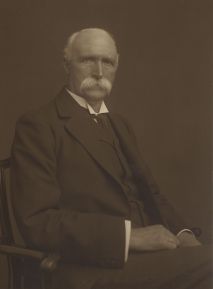On 29TH March 1916 a public meeting was held in Glasgow City Chambers to launch what the newspapers dubbed ‘The Erskine House Scheme’. The plan to open a hospital to provide care for limbless sailors and soldiers returning from the war had been developing for some months. It was suggested that eminent Glasgow surgeon Sir William Macewen with his great influence and experience should lead the initiative. The chief operating surgeons of Glasgow held a meeting to announce their unanimous support for the scheme. On the strength of this resolution a Provisional Committee was formed and included some of the most influential figures of the day: The Marquis and Marchioness of Bute, Dr James A. Adams, John Reid and Harold Yarrow to name a few.
The Lord Provost of Glasgow, Sir Thomas Dunlop later president of the hospital, lead a deputation to meet with General Sir Arthur W. May, Director General Medical Service of the Admiralty and Sir Alfred Keogh, the Surgeon General, to gain approval for the hospital. Once this was secured the committee planned to launch the scheme to the public. By the time of the public meeting £12,000 had been raised in subscriptions. On top of this, Thomas Aikman (also a committee member) had offered the free use of Erskine House for the duration of the war and for twelve months after.
The meeting, chaired by Sir Thomas Dunlop, was very well attended Messages of support were read from high-ranking military and navy officials and from Princes Louise who

Sir William Macewen (DC79-176-13)
agreed to become the hospitals patron. Sir William Macewen, gave an eloquent speech laying out the objects and purposes of the hospital:
The immediate objective was to ‘receive and treat men who have lost their limbs or who have faulty use of their injured limbs, after their discharge from the general hospitals, and to fit the limbless with artificial limbs and teach them to use these… To obtain best results sympathetic care and encouragement are required besides advice and guidance. This is what is aimed at in the establishment of the Auxiliary Hospital proposed’.
Treatment would focus not only on physical wellness but also insuring the ex-servicemen could adapt to life after leaving the hospital. Staff would make ‘inquiry into the circumstances of patients and helping them to acquire knowledge physical and mental which might aid them in their future occupation’.
The problem of artificial limb shortages would be solved by working with local shipbuilders to design and manufacture limbs. Having unbounded in the potentiality of Glasgow and in the capacity youth and vigour of her sons I have no hesitation in saying that even were we left without professional limb makers we would still get in just cause those who would make artificial limbs sufficient for the demand’
He also addressed the future of the hospital and the needs of patients beyond the war.
‘Artificial limbs require to be readjusted, repaired and renewed throughout the lifetime of a man and consequently a generation will pass before all the work connected with the maimed and limbless of this war is at an end’
The full text of Sir William Macewens speech taken from ‘The Princess Louise Scottish Hospital for Limbless Sailors and Soldiers at Erskine House’ by Sir John Reid. (ACCN 3934/3/3)
The Lord Provost proposed the resolution for the establishment of The Princess Louise Scottish Hospital for Limbless Sailors and Soldiers and commended it to the ‘generous consideration of all interested in the welfare of men who fought for King and country’. The resolution was enthusiastically and unanimously approved. The public meeting was an extraordinary success, by the end of April the hospital had received £40,000 in donations and within six months was ready to admit patients.
Keep up to date with the Erskine cataloguing project by following us on twitter: @Erskine_100
Categories: Archive Services, Library
 Johnny Beattie: ‘The Clown Prince of Scotland’
Johnny Beattie: ‘The Clown Prince of Scotland’  Lou and Kitty: a friendship in letters
Lou and Kitty: a friendship in letters  ASC Rewind: The expression of the emotions in man and animals
ASC Rewind: The expression of the emotions in man and animals
Leave a comment